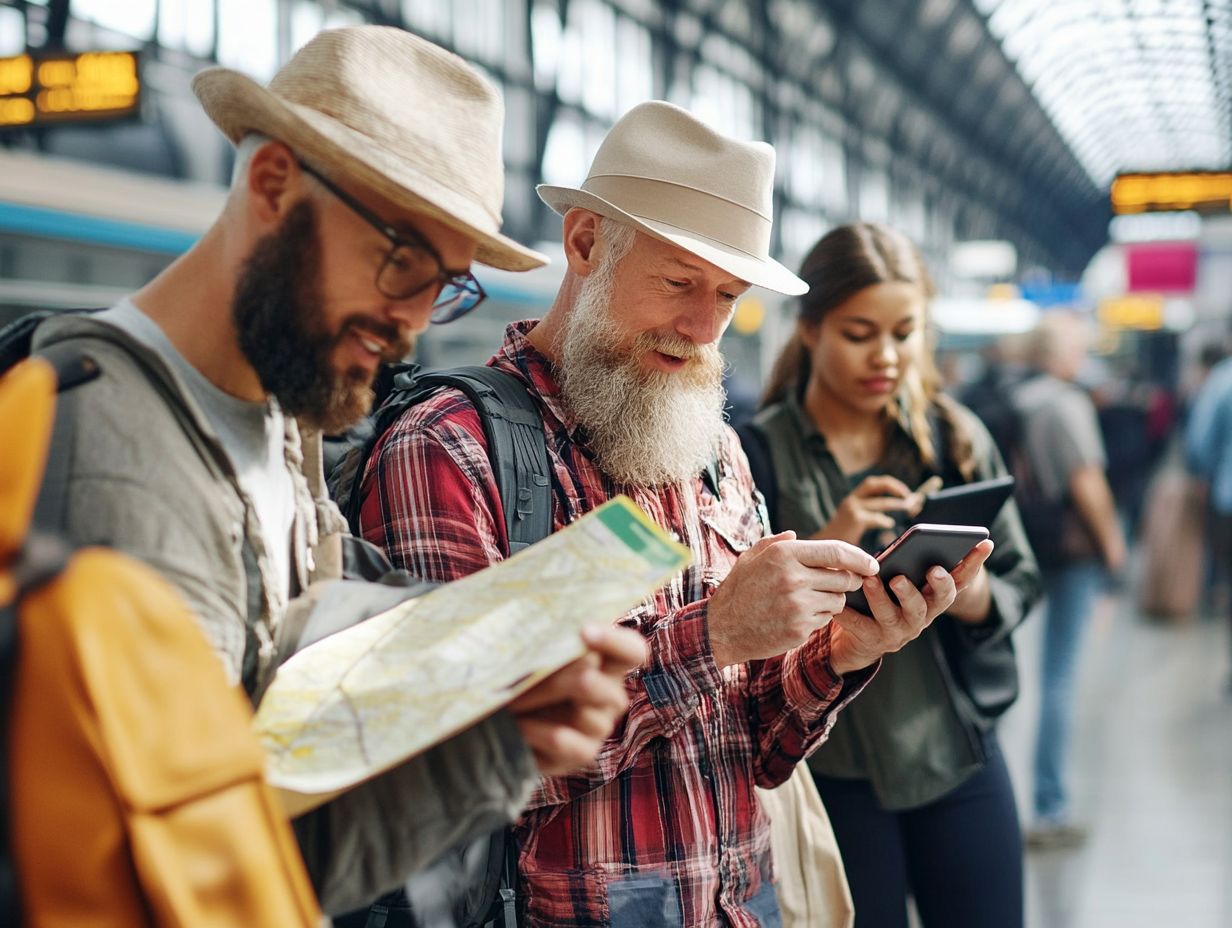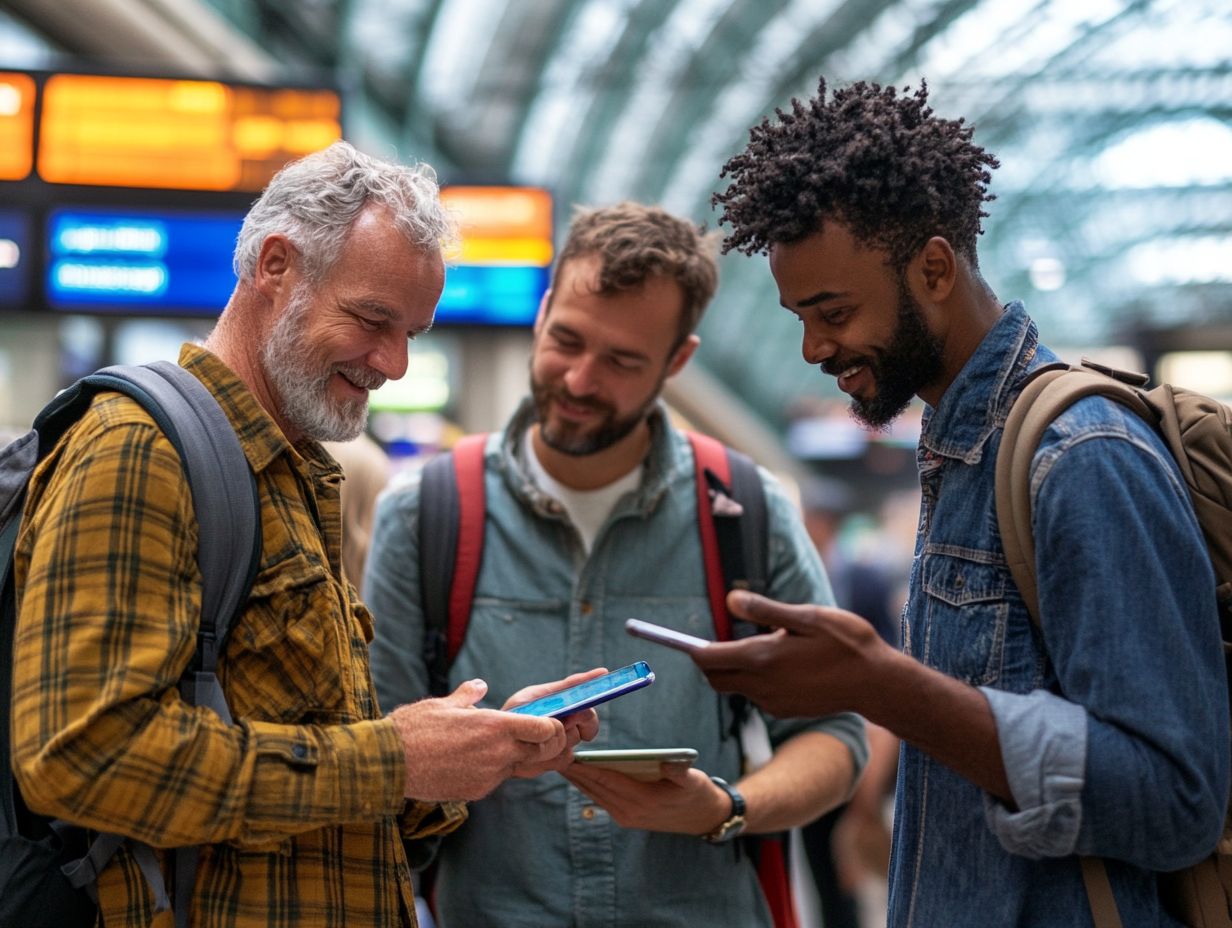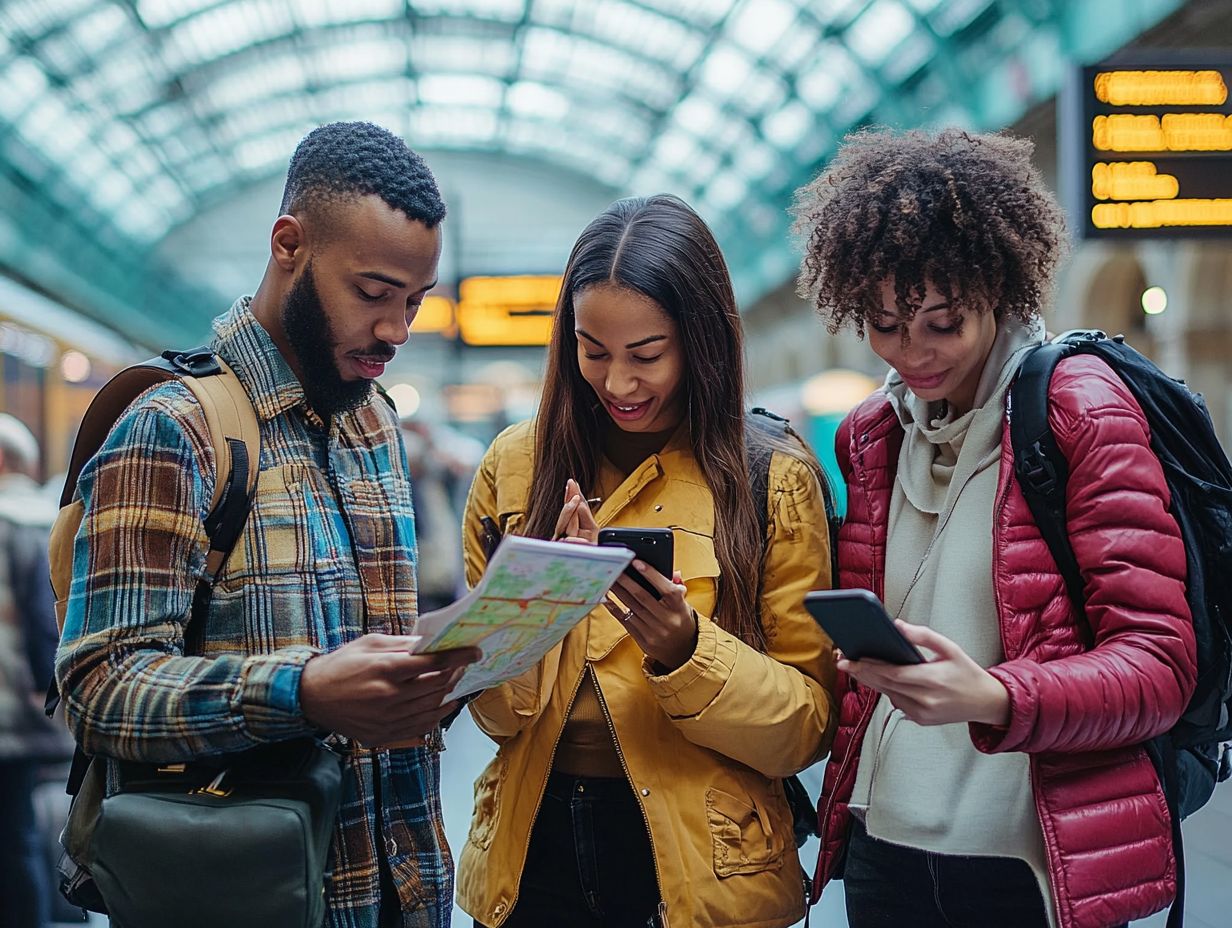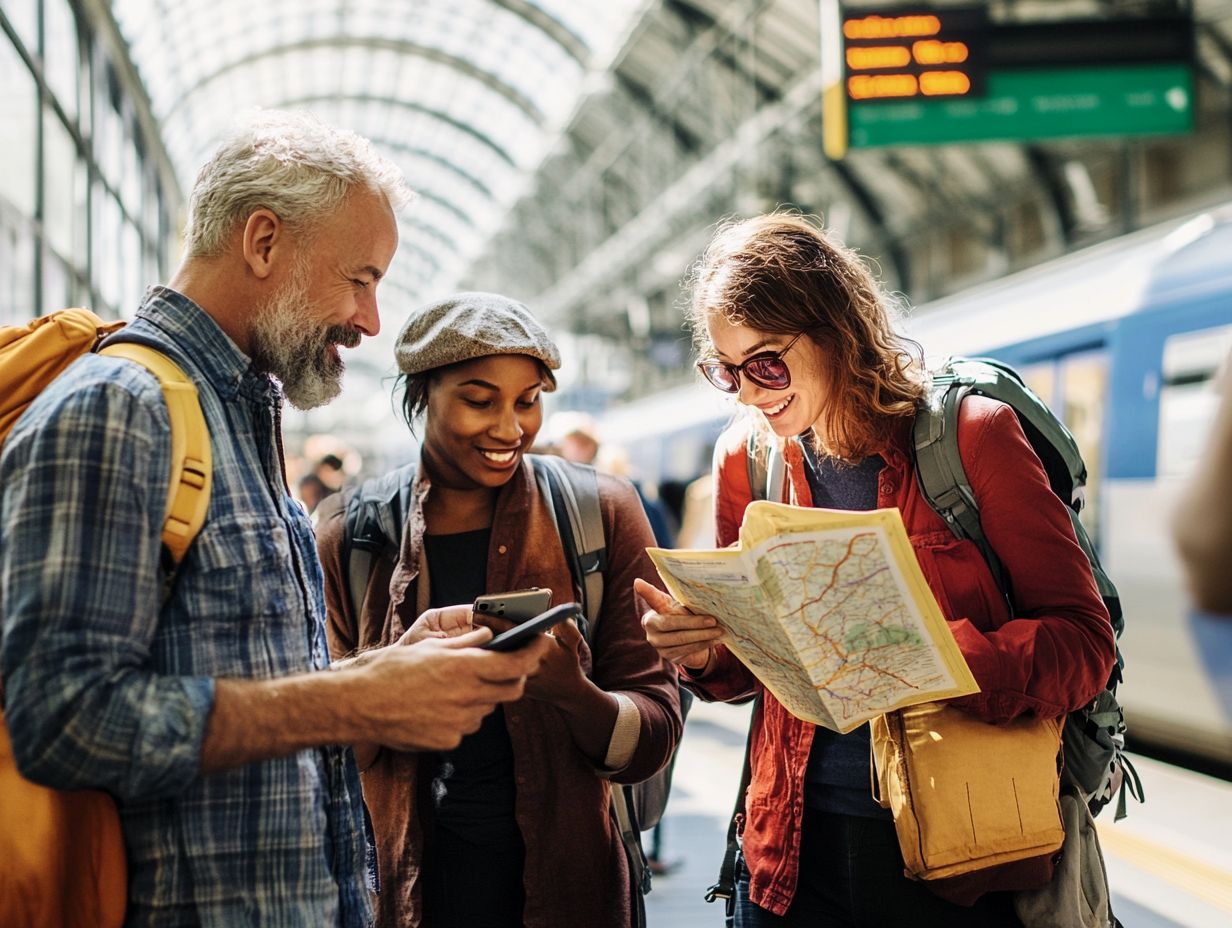5 Key Phrases for Navigating Public Transport Abroad
Navigating public transportation in a foreign country may seem intimidating at first. However, equipping yourself with the right phrases can truly transform your experience.
From locating the nearest station to inquiring about fares, mastering a few essential questions empowers you to explore new destinations with confidence. This guide is packed with must-know phrases that will make your travels unforgettable! You ll find indispensable phrases for your travels, insights into different modes of transportation, and tips for seamless navigation even in a language you might not speak fluently.
Embrace the opportunity to travel smart and enjoy a stress-free journey.
Contents
- Key Takeaways:
- 1. Where is the Nearest (Transportation Mode) Station?
- 2. How Do I Get to (Destination) from Here?
- 3. Is This the Right Train/Bus to (Destination)?
- 4. How Much Is the Fare?
- 5. What Is the Next Stop?
- What Are the Most Common Forms of Public Transportation Abroad?
- Frequently Asked Questions
- What are 5 key phrases for navigating public transport abroad?
- How do I ask for directions to the nearest public transport station?
- What is the best way to purchase tickets for public transport?
- What do I do if I get on the wrong bus/train?
- How can I make sure I get off at the right stop?
- Stay safe while exploring! Here are some tips for using public transport abroad.
Key Takeaways:

- Ask for the nearest transportation station for your preferred mode of travel.
- Confirm the route to your destination before boarding any public transport.
- Always double-check that you are on the correct train or bus for your intended destination.
1. Where is the Nearest (Transportation Mode) Station?
When you re traveling abroad, knowing how to ask, “Where is the nearest (transportation mode) station?” is essential for navigating local public transport systems. This phrase not only ensures easy communication but also enriches your travel experiences.
By mastering this vital question, you ll be able to interact with locals, ask for directions, and confidently venture into new areas. Such practical skills deepen your connection with the culture and pave the way for a more immersive and enjoyable experience.
For instance, when you re in Spain, asking “ D nde est la estaci n de (transportation mode)?” can lead to engaging conversations with friendly locals who might share extra tips or unveil hidden gems. In France, simply saying “O est la station de (transportation mode)?” can spark spontaneous dialogues.
Meanwhile, in Germany, using “Wo ist der (transportation mode) Bahnhof?” makes navigation a breeze. To boost your language skills, consider harnessing resources like Google Translate or apps such as Duolingo and Memrise. They can assist you in practicing and memorizing those essential phrases tailored to your adventures.
2. How Do I Get to (Destination) from Here?
Asking, “How do I get to (destination) from here?” is an essential travel phrase that can significantly elevate your ability to navigate unfamiliar cities and embrace local customs. This simple yet powerful question enables you to efficiently connect with locals and make the most of public transportation.
In bustling urban environments, this phrase acts as your compass, allowing you to seek directions from busy commuters or shopkeepers who are often eager to assist. In rural areas where public transport might be scarce, asking this question can cultivate a sense of community and lead to richer interactions.
When you learn to say it in the local language, you navigate better. For example, use “ C mo llego a (destination) desde aqu ?” in Spanish or “Kamu bisa pergi ke (destination) dari sini?” in Indonesian. You not only navigate better but also demonstrate respect for the culture.
For those seeking to learn these phrases effortlessly, language apps such as Duolingo and Rosetta Stone, along with travel guides featuring essential phrases, can be incredibly useful tools.
3. Is This the Right Train/Bus to (Destination)?
When you find yourself using public transportation abroad, remember to confirm, “Is this the right train/bus to (destination)?” This crucial phrase helps you ensure you’re on the correct route, preventing misunderstandings and elevating your overall travel experience.
Navigating through unfamiliar cities can feel daunting, especially when you’re pressed for time or facing a language barrier. Picture yourself in a bustling train station in Paris or a crowded bus terminal in Tokyo; learning how to use public transport like a local can save you from the stress of getting lost.
By mastering these essential queries, you can seamlessly connect with locals who are often more than willing to lend a helping hand. For instance, in Spanish, you would ask, “ Es este el tren/autob s correcto hacia (destination)?” while in Mandarin, you d say, “ destination / “
Gaining confidence in these straightforward yet effective phrases significantly enhances your travel experience, transforming public transportation into a bridge rather than a barrier on your adventures. For students, checking out 5 tips for navigating public transport can be particularly helpful.
Ready to explore? Start practicing these phrases today and boost your travel confidence!
4. How Much Is the Fare?

Understanding how to ask, “How much is the fare?” is a crucial travel expression. It facilitates clear communication with drivers and transport staff. This helps you manage your budget effectively while exploring new destinations.
This phrase becomes particularly vital when you re using public transportation options like taxis and buses, as fare structures can vary significantly between regions and countries. For example, in some cities, taxis operate on a meter system, while in others, flat rates may apply based on distance or time of day. Familiarizing yourself with local pricing policies beforehand can be tremendously beneficial.
To make your travel better, consider memorizing useful phrases such as:
- “Is there a flat rate?”
- “What is the cost to my destination?”
These key questions promote better communication and foster transparency and understanding, making your travel experience less stressful and far more enjoyable.
5. What Is the Next Stop?
The question, “What is the next stop?” is essential for you as a traveler relying on public transportation. It keeps you informed about your route and ensures you don t miss those all-important connections during your journeys.
Knowing the next stop can truly elevate your travel experience, whether you’re on a bustling train or a crowded bus. This question is crucial in new places, where local transit systems may operate quite differently from what you’re used to.
Being able to adapt this phrase into various languages can greatly enhance your interactions with drivers or fellow travelers, fostering a sense of safety and inclusiveness. Knowing what’s next allows you to prepare for your exit, making this inquiry integral not only for navigation but also for ensuring a seamless journey.
What Are the Most Common Forms of Public Transportation Abroad?
Understanding the most common forms of public transportation abroad like buses, trains, and taxis is essential for effective travel communication. Familiarity with these transport modes can significantly enhance your travel experiences and knowledge.
Buses go to many places, even hard-to-reach spots. However, you might encounter delays and overcrowding along the way.
Trains tend to be faster and more efficient for longer distances, but be prepared for higher ticket prices, especially if you opt for high-speed options. Taxis offer convenience and flexibility, though fares can vary dramatically depending on the city and the time of day.
Engaging with locals can yield invaluable tips on the best transport options, including hidden routes or lesser-known services that cater specifically to visitors. Public transport plays a critical role in connecting various destinations, allowing you to experience the everyday life, culture, and vibrancy of the places you re visiting.
What Are the Different Types of Tickets or Passes Available?
When navigating public transport, it’s essential for you to understand the various types of tickets or passes available. This knowledge gives you the power to make informed travel decisions while managing your expenses effectively.
You should also consider options like day passes. These can provide you with unlimited rides within a 24-hour period, offering the flexibility you need to explore multiple attractions without a hitch.
If you re a frequent commuter, monthly subscriptions can be a fantastic value, granting you unlimited travel over longer durations.
For example, when you find yourself at a station inquiring about tickets, you might ask, “ Cu nto cuesta un pase diario?” in Spanish, or “C t cost un bilet lunar?” in Romanian, depending on your location. Gaining a deeper understanding of these options not only helps you save money but also enhances your overall experience.
Grab your guidebook and get ready to explore!

Navigating public transportation in a foreign language can seem daunting, but with the right travel tips and essential phrases, you can make it manageable. For more insights, check out this guide on navigating public transportation in a new country. This not only enhances your journey but also deepens your appreciation for local cultures.
Using translation apps, like Google Translate, helps bridge communication gaps. These tools allow you to understand signs, maps, and schedules effortlessly. Language learning platforms such as Duolingo and Memrise offer interactive ways to learn essential vocabulary, transforming intimidating encounters into enjoyable interactions.
By memorizing a few key phrases like greetings or directions you empower yourself to engage with locals and confidently ask for help. These strategies reduce travel stress and foster connections, turning challenges into enriching adventures.
Important Safety Precautions to Keep in Mind
When using public transportation abroad, being aware of safety precautions is essential for a secure and enjoyable travel experience. This awareness lets you explore new areas without unnecessary worries.
Keep a close watch on your belongings to ensure your bags and valuables remain secure. Familiarizing yourself with key emergency phrases in the local language is invaluable, enabling you to communicate effectively in urgent situations. Understanding local customs related to safety helps you avoid misunderstandings.
For example, knowing whether it s appropriate to engage with fellow passengers or the proper etiquette for shared spaces can significantly reduce risks. Stay alert to keep your belongings safe!
A little preparation can go a long way in achieving peace of mind.
Best Resources for Planning Public Transportation Routes
Effectively planning your public transportation routes means using the best resources available. Think travel guides, Google Maps, and handy instructional YouTube videos all designed to ensure you enjoy a seamless travel experience while enriching your knowledge.
Mobile apps like Citymapper or Transit are invaluable, providing real-time updates and easy navigation. These tools are critical for any traveler. Online platforms also offer language translation tools, which are helpful when deciphering local transit signs or asking for directions.
By utilizing these resources, you can confidently navigate unfamiliar cities, enhancing your adventures along the way. They help alleviate the stress of language barriers and enable you to connect with locals, uncovering hidden gems you might otherwise miss.
Preparing for Unexpected Delays or Changes in Schedule
Being ready for unexpected delays or changes in your schedule is essential when using public transportation. This readiness makes your travels smoother and more enjoyable.
Having solid backup plans, like alternative routes or a list of nearby attractions, can turn a frustrating situation into an unexpected adventure. Learning key phrases in the local language also enhances communication, making it easier to seek assistance or make last-minute adjustments.
Embracing flexibility is vital; remember that the journey itself can be just as valuable as the destination. Those who view interruptions as opportunities often find that some of their best memories come from these unplanned moments, enriching their travel narrative.
Frequently Asked Questions

- “Where is the nearest metro station?”
- “How much is a one-way ticket?”
- “Which bus goes to (destination)?”
- “Can I buy a pass for multiple rides?”
- “Is this the right platform?”
How do I ask for directions to the nearest public transport station?
You can say, “Excuse me, where is the nearest metro station?” This is a simple and effective way to get help.
What is the best way to purchase tickets for public transport?
It varies by country. You can buy tickets at the station or use a mobile app to get them in advance.
You can often buy tickets on board for buses and trams too.
What do I do if I get on the wrong bus/train?
If you realize you re on the wrong vehicle, ask the driver or another passenger for help. You might need to get off at the next stop and find a different way to your destination.
How can I make sure I get off at the right stop?
Ask, “Excuse me, is this the (destination) stop?” or “Can you let me know when we reach (destination)?”
If you re unsure, always ask the driver or a fellow passenger for help.
Stay safe while exploring! Here are some tips for using public transport abroad.
Be aware of your surroundings and keep your belongings close. Avoid traveling alone at night, and trust your instincts.
If something feels off, don t hesitate! Get off at the next stop and choose a safer option.




